Cryotherapy Cyst Removal: A Quick & Effective Solution for Skin Cysts

If you’ve tried other ways to deal with a cyst and surgery isn’t your first choice, cryotherapy cyst removal could be the answer for you. This treatment, famed for being quick and requiring a slight recovery, uses freezing technique to destroy cysts, so no surgery is needed. Many are choosing it because it’s basic, practical and seen as less invasive than standard excision.
Although cryotherapy is most recognised for removing warts and skin tags, it can also help with certain superficial cysts. When treating a benign skin bump, the treatment works by freezing the cyst centre, breaking up the tissue and allowing the body to remove it naturally.
This article will cover everything you should know about using cryotherapy cyst removal. You will learn about the cryotherapy cyst removal, which cysts can be frozen, the benefits and risks, and what types of results to expect. We’ll also explain who should and shouldn’t have this treatment and why using a clinic like Revitalise London is essential for success.
We’ll take a closer look at the ins and outs of this treatment option today.
How Cryotherapy Cyst Removal is Performed
In cryotherapy cyst removal, a doctor applies a burst of freezing liquid nitrogen gas directly to the affected area. Freezing the cyst inside and out aims to break its cells and cause them to die. Eventually, the body removes the damaged tissue, and the cyst disappears or falls away.
1. The first steps are consultation and assessment.
A doctor will check the cyst before treatment to confirm that it can be treated with cryotherapy. If the cyst is deep or inflamed, surgery is usually necessary instead.
2. Taking care of the skin
Everything is carefully cleaned. You won’t need anaesthesia, but numbing cream can be used if your cyst is close to a sensitive body part.
3. Freezing
A cryospray machine or a cotton tip is used to apply liquid nitrogen to the cyst. Depending on the cyst’s size and depth, freezing generally takes 5 to 30 seconds.
4. Immediate After-Effects
After treatment, the area becomes white and can appear a little swollen. A little bit of burning or stinging is normal and you don't have to be concerned. It is common for a little blister to develop while the wound is breaking down.
5. Healing Begins
During the next few days, the cyst will shrink, develop a scab, and eventually return independently. Most people see improvement within 1–2 weeks.
When the cyst is treated by cryotherapy, low temperatures destroy the cyst cells and damage the lining, so the cyst cannot be filled again. This decreases the chance of the infection returning more than simple drainage.
Limitations:
If you have small, shallow cysts, cryotherapy can be very effective, but it is generally not used for:
- Cysts that are deep or very painful
- Cysts that appear infected
- Cysts that have thick walls.
If these conditions exist, surgery is likely safer and more effective. This method is quick, very clean, and usually causes only tiny scars, mostly when professionals perform it.
Cysts that Can Be Treated with Cryotherapy
Cryotherapy is meant for small, shallow cysts found on or below the skin for the best results. Freezing treatments are unsuitable for all cysts, though several react well to this option.
The Best Cysts for Treatment with Cryotherapy

1. Sebaceous Cysts
Many of these conditions are treated using cryotherapy. They appear when the pores of the sebaceous glands get blocked, keeping oil and cells inside. For small, uninflamed cysts, freezing them with cryotherapy usually destroys the cyst lining and makes it less likely for them to return.
2. Milia
These little white bumps usually appear on the face, often around the eyes or cheeks. Because they are shallow and small, they are suitable for cryotherapy.
3. Mucous Cysts
These cysts develop near your fingernails or toenails when joint fluid leaks out. Cryotherapy may be used as a simple treatment when cysts are found early
4. Mild Cysts.
Small cysts found in the chest or upper back might be treated by cryotherapy cyst removal.
5. Pilar Cysts
At times, you might find these cysts on your scalp, and they begin in hair follicles. Non-inflamed pilar cysts the size of a pea might be treated with cryotherapy, though it is more common to remove them surgically.
Cysts That Cannot Be Removed By Cryotherapy
- If the cyst is infected, treatment with cryotherapy could spread the infection or prevent pus from escaping.
- In large or deep cysts, freezing may not be able to destroy all of the cyst tissue.
- Cysts in or near the eyes or genitals—careful evaluation is required.
Why Professional Evaluation Is Important:
Your skin specialist must determine if cryotherapy is right for you. Choosing the wrong treatment may result in some skin being left behind, a new outbreak or scarring.
Advantages and Disadvantages of Cryotherapy for Removing Cysts
For people hoping to avoid surgery and want a fast solution, cryotherapy can be very beneficial for cyst removal. Considering the advantages and disadvantages before choosing this treatment for your skin issue is wise.
Reasons Why Cryotherapy Is Used for Cyst Removal
1. Minimally Invasive:
You don’t need to cut or stitch the skin during cryotherapy. Freezing the cyst with liquid nitrogen causes it to shrink before it comes off or is reabsorbed into the body.
2.Cryotherapy Cyst Removal Quick Procedure:
Most cryotherapy sessions last only a few minutes. Thus, you can get your treatment fast without waiting in a recovery area.
3. Minimal Downtime For Cryotherapy Cyst Removal:
Since treatment is brief, most people can resume their usual activities immediately.
4. A lesser chance of getting infected.
The surgery doesn’t involve a cut, so the chance of getting an infection after treatment is lower than with other approaches.
5. Affordable Option:
For most small cysts, cryotherapy is less expensive than surgically removing the cyst.
Problems Associated with Cryotherapy Cyst Removal
1. Can’t Be Used for Every Type of Cyst
Large, deep, or infected cysts can’t be treated well with cryotherapy and may have to be removed through surgery.
2. You May Have to Go More Than Once:
Not all cysts are completely resolved by just one treatment. Sometimes, you will need additional treatments to ensure the infected area is completely treated.
3. There Is A Possibility Of Hyperpigmentation.
Corticosteroids may cause the skin to lighten or darken for a short or long period in those with darker complexions.
4. Rarely Mild Discomfort or Blistering.
During application, your skin may sting; afterwards, you could get blisters or scabs.
5. Possibility Of the Cysts to Recur
A cyst may return if its entire sac is not removed.
If your doctor recommends cyst removal, cryotherapy may be a good option. Seeing a professional is essential to avoid problems or unsuccessful treatment.
What to Expect During a Cryotherapy Treatment
Learning about cryotherapy can make you feel more confident about your future. The procedure is easy, fast, and occurs in a professional health care centre.
1. Call a consultation and get an assessment of your condition.
The first part of your journey is a consultation. Anyone qualified should:
- Check your cyst to see if it’s proper for cryotherapy.
- Please tell your doctor about any medical history, your skin type, and any drugs you are taking.
- Your doctor might help you learn about what is likely going to happen due to the procedure.
- For cysts that are too deep, inflamed or infected, they may decide on a different removal technique.
2. Preparing The Skin Area for Treatment
Just before you freeze the cyst:
- The area is ensured to be very clean to stop any infection.
- A numbing cream may be applied to the skin to lower the discomfort, but most patients do not find it severe (and it is not required).
3. Cryotherapy Cyst Removal
The cyst is treated with liquid nitrogen by rubbing it with a cotton swab, using a cryoprobe, or spraying it with a special device. The cyst’s fluid freezes in the cold, destroying its internal framework.
- The freezing process takes 10 to 30 seconds each time.
- A few cases involve carrying out several freeze-thaw cycles during one session.
- After a sharp and chilling pain, you may notice a slight burning or tingling.
4. Cryotherapy Cyst Removal Immediate Aftercare
After the affected area is targeted:
- A dressing can be used on the skin if necessary.
- You’ll get advice on keeping your skin clean, moisturised and out of direct sunlight.
Cryotherapy is often done as an outpatient treatment, and you can leave the clinic immediately. A cyst usually dries out, develops a crust, and comes off in about a week or two.
Things to Keep in Mind After Receiving Cryotherapy
Cryotherapy to remove cysts is usually safe, yet it may cause some side effects, and you need time to recover afterwards. Knowing about both allows you to care for your skin and promote healing.
Usual Side Effects After Cryotherapy Cyst Removal
- Most times, side effects are mild and don’t last long. It’s common to experience:
- Redness and swelling appear in the first 24–48 hours after treatment.
- A frozen cyst may develop a blister or dry into a crust as it heals.
- Itching or tingling appears while your body is healing, but it’s not painful.
- The colour of your skin may lighten or darken temporarily, which is most common in dark skin tones.
Unusual Effects Cryotherapy Cyst Removal
- This infection is uncommon, so the area needs to be watched for pus, extra redness or spreading warmth.
- The use of cryotherapy usually results in little scarring, but poor aftercare increases the chance of scarring.
- Healing can be delayed when the treated area is prominent or irritated.
How to Heal Better After Cryotherapy Cyst Removal
What you can do after cryotherapy to help your skin:
- Day after day, wash the area with warm water and a gentle cleanser.
- Don’t remove the blister or scab yourself.
- Moisturise your face with a gentle moisturiser that doesn’t have a strong scent.
- Use sun protection (SPF 30 or higher) daily to stop pigmentation.
- Don’t apply any makeup or strong products to the area until the scar is healed.
- Don’t take showers or swim in pools or hot tubs for at least the first few days after your surgery.
Skin usually takes 7 to 14 days to recover, based on how big the cyst is and how sensitive your skin is. Looking after the wounds properly will decrease discomfort and help with faster healing.
Should You Use Cryotherapy to Handle Your Cyst?
This quick treatment doesn’t need surgery, but it’s not right for all cysts. You can choose wisely if you're open to your doctor, and have access to a good clinic like Revitalise London.
When People Find Cryotherapy Most Helpful
Many people find that cryotherapy helps relieve symptoms best when used for:
- Cysts that appear near the skin’s surface, similar to milia, sebaceous cysts or epidermoid cysts
- If your cyst isn’t inflamed: If it’s not swollen and its walls aren’t hard
- If you’re hoping to achieve a clean result and short recovery time on your face or neck
- Recurring cysts: If you’d like a simple method with less risk
We never advise using the same approach for everyone. Your treatment is always designed to be safe, sound, and look good on you.
Why Should You Choose Revitalise London for Cyst Removal?
When removing cysts, including those treated with cryotherapy, it's important to have experience, be precise, and provide good aftercare. At Revitalise London, we don’t just provide short-term solutions. We use secure treatments that match your cyst’s features and your skin type.

Experienced Doctors Specialising In Skin Care & Cryotherapy Cyst Removal
Our specialists have been taught how to use cryotherapy to remove cysts. They know when it’s best to use cryotherapy and when other techniques might be preferable. Since we’ve worked in dermatology and aesthetic procedures for many years, you can count on us for accurate results
- Close examination before treating the infection
- If you are told cryotherapy isn’t right, here, you would only get honest advice.
- Cryotherapy Treatments Personalised for You
- Some cysts react differently to the treatment than others. That’s why we change our approach: The freezing process is customised according to the kind of cyst and its position.
- The number of sessions will depend on whether the cyst is treated in stages.
- Custom routines that help your skin after each treatment
- Wherever your cyst is located—on the face, back or scalp—we choose the safest way to remove it
- Comfortable on the skin and smooth the healing process
Revitalise London is celebrated for its excellent aftercare. When your cyst is treated, our medical team offers:
- A plan to reduce the inflammation to the treatment
- Guidance about products meant to care for the skin after surgery and to prevent scars
- You will receive follow-up appointments to check on your skin’s condition.
- We concentrate on producing natural healing, the least amount of scarring and no complications.
- Many clients in London depend on us.
- Our clients select us for what we do and how we care for them.
- Being told what will take place before and after the treatment
- Nice and helpful staff
- A clinic that is freshly updated with the latest technologies.
- It’s important to us that you feel entirely confident before, during and long after your treatment.
Cryotherapy might seem like an easy answer—at Revitalise London, it’s combined with other carefully planned treatments. If you’re dealing with a cyst and want clear advice, we can provide it every step of the journey.
Is Cryotherapy Cyst Removal a Good Option for You?
Many people who have trouble with stubborn cysts find that cryotherapy cyst removal is both safe and effective. Since it is precise and minimally invasive, it becomes attractive for cysts in challenging or sensitive body parts. Getting the best results requires professional testing and a personalised treatment plan, and that’s just what Revitalise London provides.
Our team of experts, customised care and strong aftercare make your cyst removal journey as easy and successful as possible. Revitalise London is the place to visit if you consider cryotherapy cyst removal.
Appointments are available now to discuss cryotherapy and how it can eliminate cysts for you.
